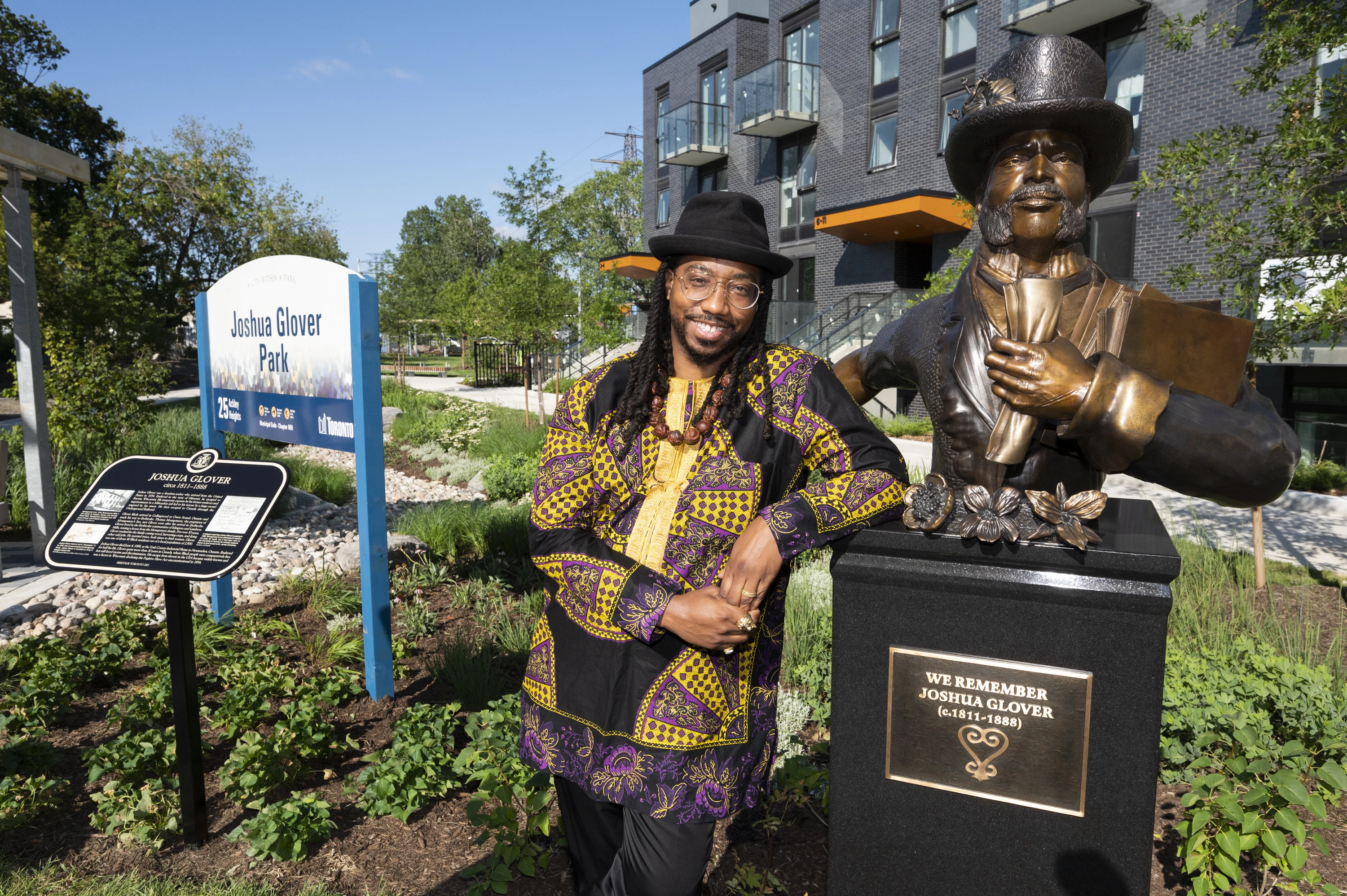
Mathieu Da Costa, 17th Century
We are delighted to commemorate Mathieu Da Costa with a statue. This page showcases the creation process, featuring the talented artist Quentin VerCetty.
Mathieu Da Costa occupies a unique and mysterious place in Canadian history, embodying the spirit of cross-cultural exchange and linguistic prowess. Historical records indicate that Da Costa was active during the 17th century, serving as an interpreter for European colonial expeditions in Canada. Fluent in an impressive array of languages, including those of European settlers and various Indigenous groups, Da Costa played a pivotal role in bridging communication gaps and fostering understanding between disparate cultures.
In 2017, Canada Post commemorated Mathieu Da Costa by issuing the stamp below. Illustrator Ron Dollekamp, storyboard artist Francis Back, and designer Andrew Perro created the illustration with extreme care and caution for historical accuracy. The artists paid attention to details like the style of dress and look of the sailing ships Da Costa may have voyaged upon when he was alive. The three artists selected by Canada Post to work on the Canada Post stamp honoring trailblazer Da Costa were non-Black Canadians. The stamp was released on February 1st, 2017. Da Costa had a prestigious position working for the French fur trader, explorer, and governor of Acadia, Pierre Dugua de Mons. It is of great importance to the Black community that the first Black person of African heritage recorded to have migrated to, and lived in Canada, was a free man, employed in a career as an interpreter. Da Costa spent most of his time in Canada translating between explorers and indigenous people in New France, now Quebec.

Significantly, Da Costa was recognized as part of Canada’s sesquicentennial stamp series in 2017. As part of the stamps in this series highlighting this significant moment, the phrase ‘Canada 150’ and a red sesquicentennial logo may be found at the top of the stamp when viewed under black light.
Da Costa was an African from the Benin Empire of West Africa who French explorers employed as a translator for expeditions to the New World. Mathieu was also known by the name d'Acosta at times. Even though he might have arrived sooner, it wasn't until the 1600s—during the expeditions of explorers, Pierre Dugua, Sieur de Mons, and Samuel de Champlain—that his presence in Canada was officially documented.
Known as a freeman, he reportedly picked up multiple languages while still in Africa from European traders doing business with the Edo people of the Benin Empire. At the start of the 21st century, the Edo population spanned 3.8 million people.
Beyond just being an interpreter, Da Costa's legacy includes entrepreneurship. He used his language skills and ability to connect across cultural differences to secure employment in what may be considered today as a modern-day consultant interpreter. He was good at moving between the Indigenous and European worlds, which shows how well he could adapt to tough times and change. Mathieu Da Costa isn't just a person from history; he represents adaptability, inclusive approaches to day-to-day living, cleverness, and the prioritization of communication and clarity across cultures, even during difficult times.


Mathieu Da Costa's impact transcended mere interpretation; he was a crucial mediator, fostering understanding between Indigenous peoples and European settlers. In navigating the complexities of intercultural relations with sensitivity and diplomacy, Da Costa bridged divides, promoting dialogue and cooperation amidst colonial expansion. His legacy reflects a nuanced approach to diplomacy, emphasizing mutual understanding and cooperation in a rapidly changing world.
Artist Bio
Quentin VerCetty is an award-winning multidisciplinary artist known for pioneering Afrofuturist narratives and cultural activism. His iconic Joshua Glover statue, Toronto's first monument celebrating African heritage, earned him the 2021-22 Fine Art Award. As the first artist commissioned by Carnegie Hall for their Afrofuturism-themed season, VerCetty coined terms like "Sankofanology" and "Rastafuturism." He founded the Black Speculative Arts Movement Canada in 2016 and AstroSankofa Arts Initiatives in 2022. VerCetty's passion for community empowerment and ancestral homage infuses his work, inspiring hearts and minds worldwide.

REFERENCES:
African American Registry -AAR. Mathieu da Costa, Explorer born.
https://aaregistry.org/story/mathieu-da-costa-explorer-born/
Black Cultural Centre for Nova Scotia. African Nova Scotian History Timeline Highlights.
Our History – Black Cultural Centre for Nova Scotia (bccns.com)
Canada Post. (January 24, 2017). Canadian Stamp Stories: Black History: Mathieu Da Costa.
Black History: Mathieu Da Costa | Canada Post (canadapost-postescanada.ca)
CBC Kids team. (January 23, 2023). The first recorded Black man in Canada became a
national hero. Canadian Broadcasting Corporation -CBC.
(https://www.cbc.ca/kids/articles/the-first-recorded-black-man-in-canada-became-a-national-hero)
Lambert, Maude-emmanuelle; Millette, Dominique; and Poulin, Jessica. (June 25, 2013, then
February 7, 2023). Mathieu Da Costa. Canadian encyclopedia.
https://www.thecanadianencyclopedia.ca/en/article/mathieu-da-costa
Government of Canada. (Modified on 2024-02-01). Significant events in Black history in
Canada. Significant events in Black history in Canada - Canada.ca
Martin, Shayla. (Sept. 12, 2022). A Journey Through Black Nova Scotia. New York Times.
A Journey Through Black Nova Scotia - The New York Times (nytimes.com)
The Canadian Museum of History. African Nova Scotians: 20th Century Canadian Legacies.
William, Noah. (September, 2024). The Incredible Story of Canada's First African | Mathieu
Da Costa. The Incredible Story of Canada's First African | Mathieu Da Costa - YouTube

